At the heart of Christmas celebrations worldwide is the commemoration of the birth of Jesus Christ, a pivotal figure in Christianity. This occasion is marked with an outpouring of religious and cultural observances, reflecting on the nativity story of Jesus’ humble beginnings in a manger in Bethlehem. The essence of Christmas extends beyond its historical roots, embodying themes of hope, joy, peace, and goodwill towards all.

Christmas Down Under
In Australia, where Christmas falls during summer, these traditions take on a local flavour. Beach visits and barbecues often accompany traditional celebrations, but the core sentiments remain unchanged.
Australians embrace the spirit of giving and community, sharing this special time with family and friends while remembering its origins and reverently celebrating the birth of Jesus Christ amid the festive cheer.
Christmas Customs And Traditions
Humans love to take inspiration from different cultures, customs, and traditions; believe it or not, Christmas is no different. If you thought those cosy traditions you knew and loved were just about celebrating Christmas, think again! Things like kissing under mistletoe, carolling, wreaths, and even gift-giving were all aspects of pagan holidays that were adapted into Christmas celebrations in the early years. Festivals like Yule and Saturnalia played a significant role in shaping these customs.
Yule, a winter solstice festival, and Saturnalia, an ancient Roman festival, contributed to modern Christmas customs such as feasting, decorating with greenery, and the spirit of merrymaking.
Decorating trees, feasting with loved ones, hanging up socks by the fireplace, and drinking yourself silly are no different—they’re all part of pagan history and sacred holidays. Most of the cultural aspects we associate with Christmas are steeped in pagan roots.
Some pagan traditions that have become associated with Christmas celebration:
- Gift-giving,
- The image of Santa Claus,
- Christmas stockings,
- Christmas carolling,
- Decking the halls with Holly
- Decorating evergreen trees.

Fine Dining with A Private Chef
Who were the Pagans? Exploring their pagan origins
First, what do we mean when we say pagan? This sweeping term encompasses anyone from the Romans to the Norse in Scandinavia. As Christianity spread through Europe in the early ADs, missionaries met many different groups of people with varying religious systems and beliefs. All of these people and religions were lumped into the catch-all term of ‘pagan’.
Although Christians aimed to spread their religion across Europe, they were still quite fascinated by many of the pagans’ customs and ways. Many of these customs were rooted in pre-Christian traditions, such as ancient Roman winter solstice celebrations and other pagan rituals. Druids and Celtic traditions, for example, were among the pagan customs adopted by early Christians.
They were fascinated enough to adopt a few of those beliefs and traditions as part of Christian celebrations, which eventually evolved into various Christmas traditions!
The winter solstice celebration
Keep reading, and you’ll find that Christmas is inspired by traditions from the Romans, Celtics, Norse, Druids, and more (all pagan). At the time, these different groups shared one big celebration that happened to fall around Christmas – the winter solstice. People living in the northern hemisphere celebrate the winter solstice (or the shortest day of the year) smack bang in the middle of December, and this is why Christmas just so happened to fall around the same time as many existing pagan holidays.
The winter solstice was a huge part of pagan life. As they were primarily agricultural people, winter marked the end of the year’s harvest and the chance to enjoy the company of loved ones and rest from toiling the fields. Pagans could stop farming through the winter and instead devote themselves to worshipping their various gods and celebrating with those around them.
Winter solstice celebrations, such as Roman Saturnalia and the Germanic Yule festival, symbolized hope and rebirth. They incorporated customs like feasting, gift-giving, and various rituals that embraced the return of longer days. As winter in the northern hemisphere tends to be dark, cold, and hungry, the winter solstice was celebrated to help keep people entertained and enjoy themselves until the sun rolled around again.
Popular Christmas Traditions
Now that you know the background, let’s examine some pagan traditions from festivals like Yule and Saturnalia that have become associated with Christmas.
1. Gift-giving and Saturnalia
Not only is December a time to celebrate winter solstice, but between the 17th and 24th of the month, the Romans also celebrated Saturnalia. This was a pagan holiday in honour of the agricultural god Saturn. In ancient Rome, Romans would spend the week of Saturnalia much like Christmas holidays today – feasting, drinking, exchanging gifts, and being joyful.
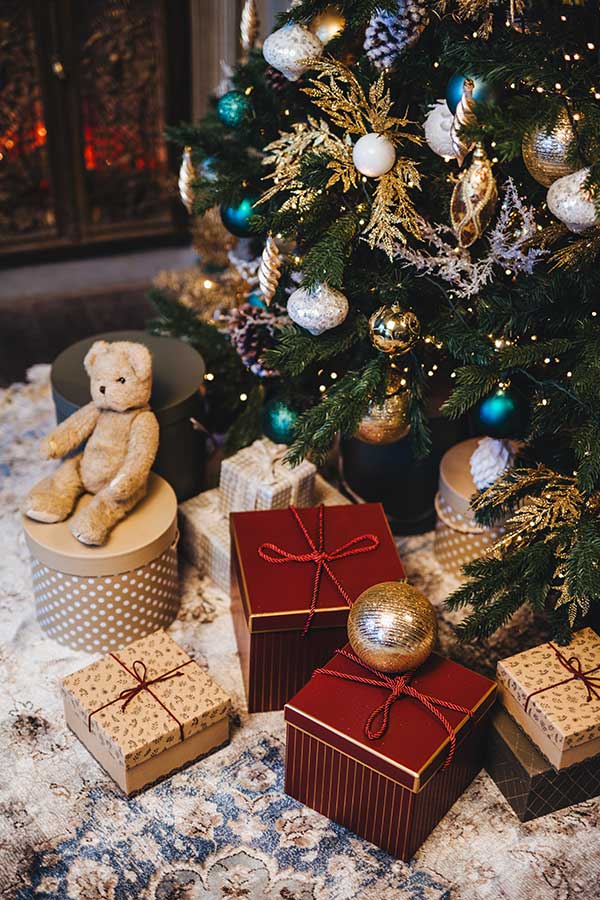
Christmas Eve also holds significant cultural importance in various parts of the world, such as the Feast of the Seven Fishes in Italy, which features a seafood meal, and Las Posadas in Mexico, which emphasizes family and community through unique culinary traditions.
Nowadays, we spend a lot of money on Christmas gifts, but back then, the Romans exchanged small gifts for good luck. The idea was to give a gift, hoping to bring in a bountiful harvest the next year. Yule, another festival, also influenced these gift-giving traditions, emphasizing the exchange of tokens for prosperity.
Rather than having huge lists of gifts to give, the Romans also shared only one gift with one other person. Somewhere along the line, giving presents for luck and prosperity became a multimillion-dollar business. Isn’t that funny?
Check out our article, Ideas for the Work Christmas Party for Small and Medium Businesses.
2. Santa’s image & Christmas stockings
Our current modern-day image of Santa Claus, clad in red fur with a big white beard, was largely developed by Coca-Cola in the 1930s. But the idea of an old man giving gifts to children dates much earlier than that, back to the time of the pagans.
Father Christmas, or St. Nicholas, was a patron saint of children, the poor, and prostitutes. Living around the 4th century AD, St. Nicholas was a generous bishop known for giving gifts to the poor, sporting a big beard and a long cloak, much like the Santa we know and love.
But even before St. Nicholas, there was another bearded old man called Odin. This deity was worshipped by early Germanic pagan tribes, traditionally portrayed as an old man with a long, white beard and an 8-legged horse called Sleipnir, who he would ride through the skies (just like Santa’s reindeer).
During the winter, kids would fill their booties with carrots and straws and leave them by the chimney for Sleipnir to feed on. Odin would fly by and reward the children with little presents in their booties, much like we do with Christmas stockings today.
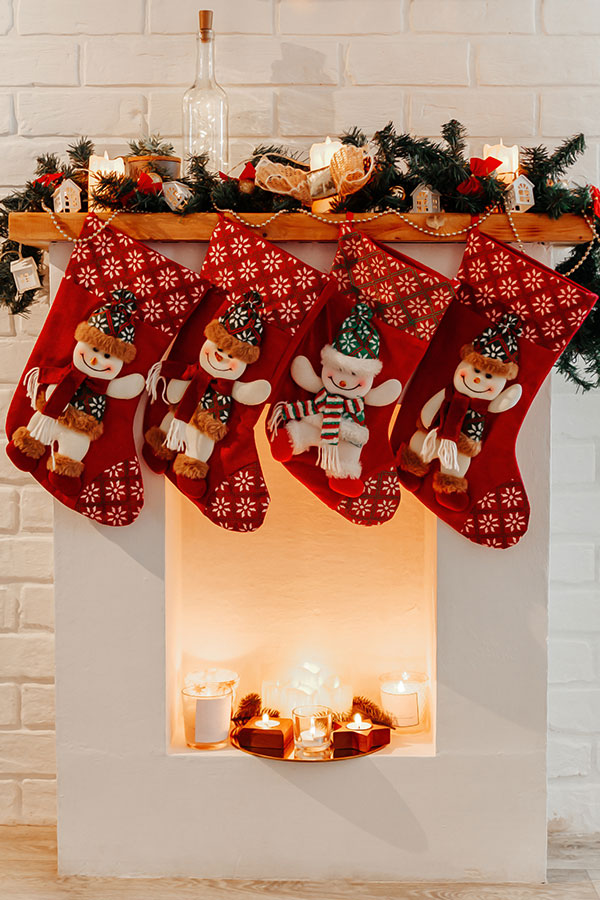
The Santa Claus we all imagine today is a mishmash of the generous St. Nicholas, the god Odin and Sleipnir, and Coca-Cola’s iconic red-dressed character. The traditions of Yule and Saturnalia also influenced the modern image of Santa Claus and the tradition of Christmas stockings.
3. Christmas carols
Christmas carols are the creed of Christendom. While the carols we sing for Christmas are undeniably Christian, the tradition of going door-to-door singing to your neighbours comes from another pagan tradition called wassailing.
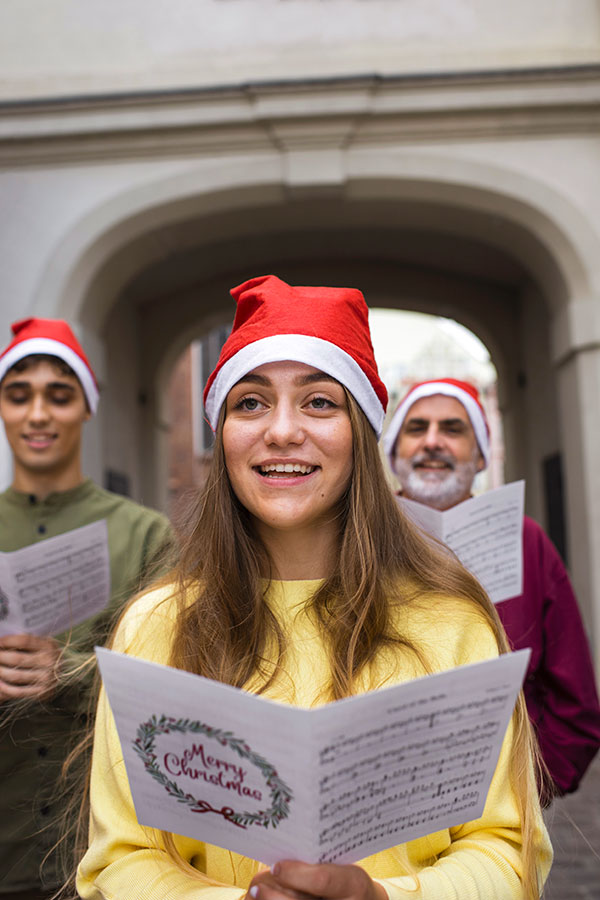
The rather funny word comes from the Anglo-Saxon phrase ‘waes hael’, translating to ‘good health’. Every year, wassailers would roam through their villages in small groups, singing loudly to banish evil spirits and wish good health to those around them.
No wassailing group was complete without their traditional drink on hand – made from mulled ale, curdled cream, roasted apples, eggs, spices, and sugar. St. Francis, in the 13th century, took inspiration from the wassailers and began the Christmas tradition of door-to-door carolers. Yule, another festival with deep-rooted customs of communal singing and celebration, also influenced the tradition of festive singing.
4. Kissing under a mistletoe
Ever wonder about the correlation between mistletoe and kissing? The Significance of Holly and Mistletoe Holly Holly and mistletoe were sacred plants for the pagans.
Funnily enough, the tradition goes back to the pagans. Everyone from the Romans and Celts to the Druids and the Norse knew about mistletoe. It was considered a highly sacred plant and was involved in several pagan rituals.
In the Roman world, mistletoe honoured the god Saturn. To keep him happy, they would perform fertility rituals underneath sprigs of mistletoe – yes, that’s exactly what it sounds like! We’ve toned it down as far as mistletoes are concerned and left it with just a simple kiss – probably a good idea since family is always around.
In the world of the Druids, mistletoe symbolized peace and joy. In times of war, if enemies met underneath woodland mistletoe, they would drop their weapons and form a truce until the next day. In a way, kissing is a form of truce…
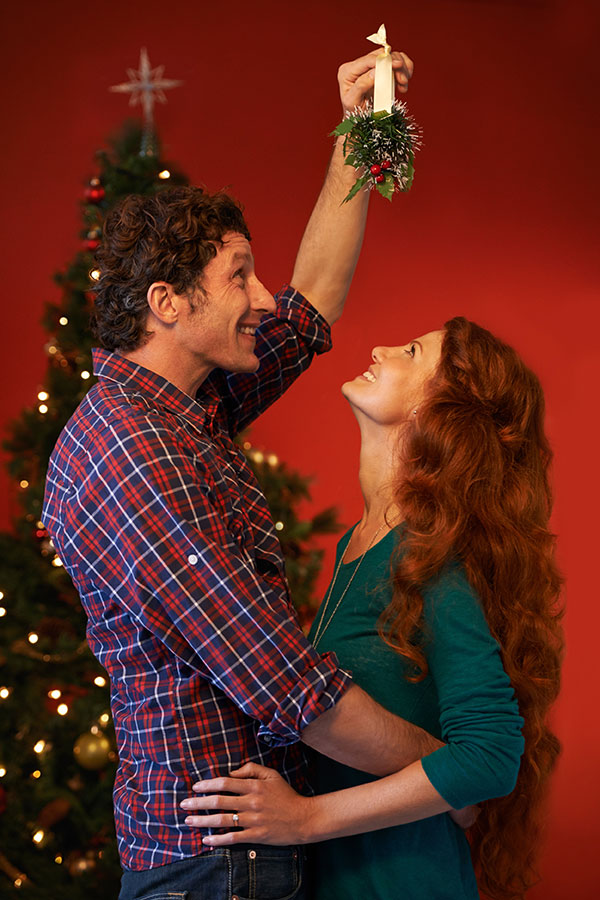
5. Decking the halls with holly
Mistletoe wasn’t the only sacred plant for pagans. Holly was another holy plant connected with the god Saturn. During the Saturnalia holiday, Romans made holly wreaths to exchange as gifts for good luck.
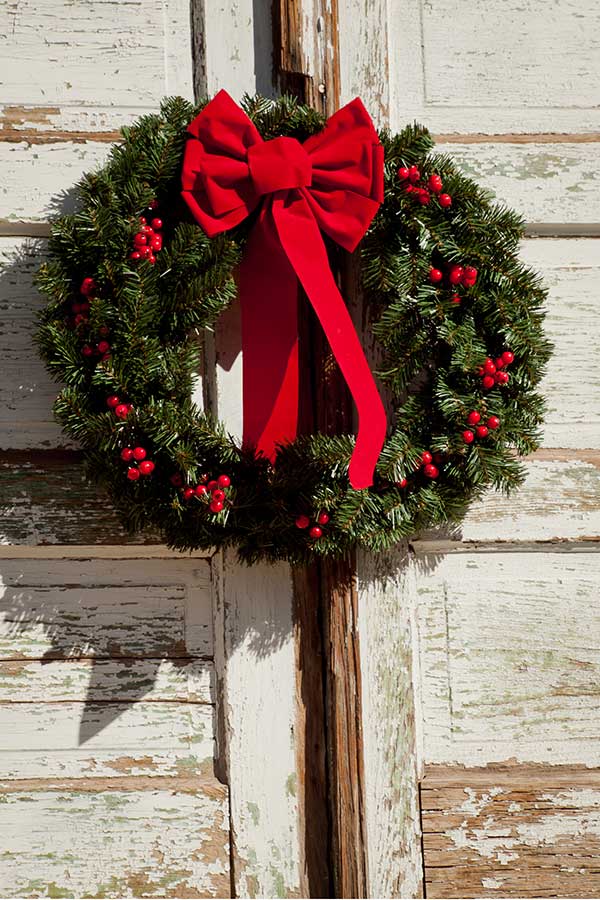
Early Christians began to celebrate Christmas during Saturnalia and Yule; however, they were often persecuted for practising their new religion. It was lucky that Christmas coincided with Saturnalia, allowing Christians to have a cover for their Christmas celebrations.
To avoid detection and make it look like they were celebrating Saturnalia, Christians started hanging holly wreaths around their homes. This allowed them to recognise other Christians and still do something nice to celebrate their sacred holiday. Eventually, as pagans decreased, holly became a symbol of Christmas instead of Saturnalia.
6. Christmas tree decorating
We sure have taken a lot of inspiration from the Romans, and tree decorating is just another borrowed tradition! During Saturnalia, Romans feasted, drank, and exchanged gifts. They also hung small metal ornaments on trees outside their homes. These little ornaments represented a god, Saturn or the family’s personal patron saint.
Early Germanic tribes practised a similar tree-decorating tradition, with fruits and candles, to honour the god Odin throughout the winter solstice. Yule, another festival, also involved tree decorating traditions. Christians seem to have merged tree decorating with ornaments, candles, and fruits to make Christmas tree decorating one extravagant tradition.
Christmas trees symbolize the blending of secular and religious traditions, particularly in non-Western societies that have adopted the secular aspects of Christmas. They also address the debates around their pagan roots and acceptance of Christian practices.

Pagan origins of Christmas traditions
Christmas traditions, rich in history and vibrant in celebration, often trace back to ancient pagan roots, particularly the festivals of Yule and Saturnalia. The iconic Christmas tree, adorned with ornaments and lights, originates from early Germanic tribes and Roman customs celebrating the winter solstice.
Similarly, Easter, another major Christian holiday, carries pagan origins linked to springtime festivities. These traditions highlight the fascinating blend of secular and religious practices, showcasing how modern celebrations are deeply intertwined with ancient customs.

Fine Dining with A Private Chef
Fine Dining Experience for Your Christmas.
A private chef can elevate your Christmas celebration to an unforgettable experience. Imagine indulging in a fine dining experience in your home, where every dish is a masterpiece tailored to your tastes and dietary preferences. Good food, crafted with expertise and passion, can transform your festive gathering into an intimate and luxurious event.
As each course is meticulously prepared and presented, you and your guests will be taken on a culinary journey that encapsulates the spirit of Christmas. Beyond just a meal, it’s a personalised service that adds warmth and sophistication to your holiday celebrations, leaving everyone with cherished memories. Is there something different this Christmas? Get a Private Chef to host an unforgettable Christmas Dining Experience.

If you are interested in Pagan culture, you might want to know The Pagan Origins of Easter.